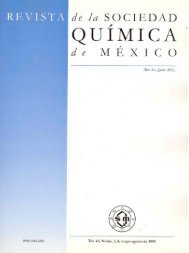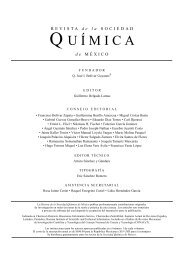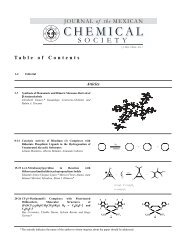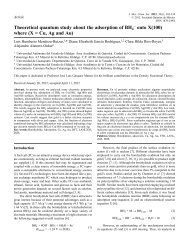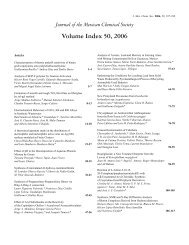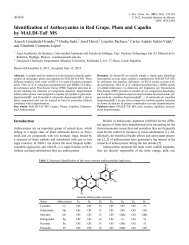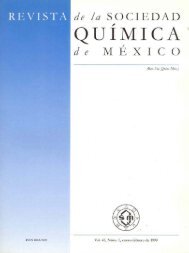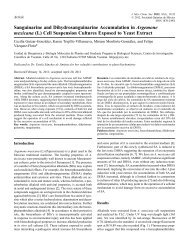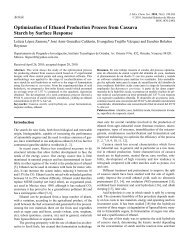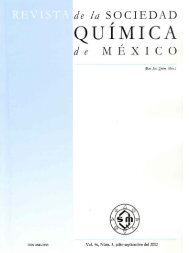SMQ-V047 N-002_ligas_size.pdf - Journal of the Mexican Chemical ...
SMQ-V047 N-002_ligas_size.pdf - Journal of the Mexican Chemical ...
SMQ-V047 N-002_ligas_size.pdf - Journal of the Mexican Chemical ...
You also want an ePaper? Increase the reach of your titles
YUMPU automatically turns print PDFs into web optimized ePapers that Google loves.
Isolation and <strong>Chemical</strong> Transformations <strong>of</strong> Some Anti-inflammatory Triterpenes from Salvia mexicana... 171<br />
Table 4. Anti-inflammatory activities <strong>of</strong> 8 and 9.<br />
Compound Edema Inhibition (%)<br />
(mg, average SE)<br />
Control (EtOAc) 11.80 ± 0.045 -<br />
2- Formyl-3-oxo- 3.03 ± 0.86 74.29*<br />
urs-28-oic acid<br />
methyl ester (8)<br />
2- Formyl-3-oxo- 3.03 ± 0.86 74.29*<br />
urs-1-en-28-oic<br />
acid methyl ester (9)<br />
All <strong>the</strong> compounds were tested at 1 mg / ear doses. The results were analyzed<br />
by ANOVA. Statistical comparison were made between control group and <strong>the</strong><br />
experimental groups using a t student test. *p ≤ 0.01. The reported % <strong>of</strong> inhibition<br />
<strong>of</strong> ursolic acid is 74.4 % at 1 mg/ear doses [16].<br />
2- Formyl-3-oxo-urs-1-en-28-oic acid methyl ester (9).<br />
PhSeCl (120 mg) was dissolved in 12 mL <strong>of</strong> CH 2 Cl 2 and<br />
cooled to 0 °C and 0.06 g (40 µl) <strong>of</strong> pyridine was added. After<br />
15 min, 0.2 g <strong>of</strong> 8 in 3 mL <strong>of</strong> CH 2 Cl 2 was added and <strong>the</strong> mixture<br />
was stirred for 15 min more. The CH 2 Cl 2 solution was<br />
extracted with two 5 mL portions <strong>of</strong> 10 % HCl and cooled<br />
back to 0 °C, at which time 0.1 mL <strong>of</strong> 30 % H 2 O 2 was added.<br />
An additional 0.1 mL <strong>of</strong> 30 % H 2 O 2 was added after 10 min<br />
and again after 20 min. After an additional 10 min, 0.5 mL <strong>of</strong><br />
H 2 O was added and <strong>the</strong> CH 2 Cl 2 layer was separated and<br />
washed with 5 mL <strong>of</strong> saturated NaHCO 3 . After being dried<br />
over Na 2 SO 4 , <strong>the</strong> solution was filtered and <strong>the</strong> solvent evaporated<br />
under vacuum to yield 9 (53 mg; 0.11 mmol; 24 %<br />
yield). Reddish viscous liq. IR (CHCl 3 ) ν (cm –1 ): 2921, 2858,<br />
2721, 1719, 1672, 1604, 1455, 1379, 1224 and 1110. EIMS<br />
70eV m/z: 494 (M + , C 32 H 46 O 4 ), 479, 476, 435, 419, 314, 262,<br />
249, 233, 203, 189, 158, 133 and 117. 1 H NMR (200 MHz,<br />
CDCl 3 ): 10.01 (1H, s, COH), 7.80 (1H, s, H-1), 5.38 (1H, m,<br />
H-12), 3.62 (3H, s, OMe), 2.28 (1H, d, H-18), 1.25, 1.18,<br />
1.09, 0.96, 0.87 (3H, s, each), 1.17 (3H, d, J = 7 Hz), 0.87<br />
(3H, d, J = 8Hz).<br />
Free radical scavenging Activity. DPPH assay was performed<br />
essentially according to <strong>the</strong> modified method <strong>of</strong><br />
Cottele. Reaction mixture containing different concentrations<br />
<strong>of</strong> test samples in DMSO and 100 mM DPPH ethanol solution<br />
in 96-well microliter plates, were incubated at 37 °C for 30<br />
min, and subsequently <strong>the</strong> absorbencies were measured at 515<br />
nm in a microplate reader Elx 808. Measurements were performed<br />
in triplicate in at least three independent experiments.<br />
The % inhibition <strong>of</strong> each compound was determined by comparison<br />
with a DPPH ethanol blank solution [22]. The results<br />
were analyzed by ANOVA. Statistical comparisons were<br />
made between control group and <strong>the</strong> experimental groups<br />
using Dunnet’s test.<br />
Animals. Male CD-1 mice, weighing 20-25 g each were used.<br />
Instituto de Fisiología Celular, Universidad Nacional Autónoma<br />
de México provided <strong>the</strong> experimental animals. All animals<br />
were held under standard laboratory conditions in <strong>the</strong> animal<br />
house (temperature 27 ± 1 °C). They were fed laboratory diet<br />
and water ad libitum. All experiments were carried out using<br />
4-8 animals per group.<br />
TPA-induced edema model. Effects <strong>of</strong> <strong>the</strong> test substances on<br />
TPA-induced ear edema in mice were studied as described by<br />
De Young [17] with slight modifications. The substances (1<br />
mg / ear) were applied topically. A solution <strong>of</strong> TPA (2.5 µg)<br />
in EtOH (10 µL) was applied topically to both faces (5 µL<br />
each face) <strong>of</strong> <strong>the</strong> right ear <strong>of</strong> <strong>the</strong> mice, 10 min after <strong>the</strong> test<br />
substances were applied (10 µL each face). The left ear<br />
received ethanol (10 µL) first, and 20 µL <strong>of</strong> <strong>the</strong> respective solvent<br />
subsequently.<br />
Four hours later <strong>the</strong> mice were killed by cervical dislocation.<br />
A 7-mm diameter plug was removed from each ear. The<br />
swelling was assessed as <strong>the</strong> difference in weight between<br />
right and left ear plugs [19]. Inhibition <strong>of</strong> edema (EI, %) was<br />
calculated by <strong>the</strong> equation:<br />
EI (%) = 100 – [B × 100 / A], with A = edema induced by<br />
TPA alone, and B = edema induced by TPA plus sample.<br />
Data were expressed as <strong>the</strong> mean SEM <strong>of</strong> 4-8 mice. All<br />
<strong>the</strong> extracts and compounds were tested at 1 mg / ear doses.<br />
The results were analyzed by ANOVA. Statistical comparisons<br />
were made between control group and <strong>the</strong> experimental<br />
groups using a t student test. *p < 0.01.<br />
References<br />
1. Lu, Y.; Yeap-Foo, L. Phytochemistry 2<strong>002</strong>, 59,117-140.<br />
2. Baricevic, D.; Sosa, S.; Della Logia, R.; Tubazo, A.;<br />
Simonovska, B.; Krasna, A.; Zumpancic, A. J. Ethnopharmacol.<br />
2001, 75, 125-132.<br />
3. Chang, H. M.; Cheng, K. P.; Choang, T. F.; Chow, H. F.; Chui,<br />
K. Y.; Hon, P. M.; Lau Tan, F. W.; Yang, Y.; Zhong, Z. P.; Lee,<br />
C. M.; Sham, H. L.; Chan, C. F.; Cui, Y. X. J. Org. Chem. 1990,<br />
55, 3537-3543.<br />
4. Zhang, K. Q.; Bao, Y.; Wu, P.; Rosen, R. T.; HO, C. T. J. Agric.<br />
Food Chem. 1990, 38, 1194-1197.<br />
5. Tang, W.; Eisenbrand, G. Chinese Drugs <strong>of</strong> Plan Origin. Chemistry,<br />
Pharmacology, and use in Traditional and Modern Medicine.<br />
Springer-Verlag, Berlin, Heidelberg, 1992, pp. 891-902.<br />
6. Rodríguez-Hahn, L.; Esquivel, B.; Cárdenas, J. Recent Advances<br />
in Phytochemistry, 1995, 29, 311-332.<br />
7. Takahashi, K.; Ouyang, X.; Komatsu, K.; Nakamura, N.; Hattori,<br />
M.; Baba, A.; Azuma, J. Biochem. Pharmacol., 2<strong>002</strong>, 64, 745-<br />
750.<br />
8. Cao, C-M.; Xia, Q.; Zhang, X.; Xu, W-H.; Jiang, H-D.; Chen, J-<br />
Z. Life Sciences, 2003, 72, 2451-2463.<br />
9. Ebringerova, A.; Kardosova, A.; Hromádkova, Z.; Híbalova, V.<br />
Fitoterapia, 2003, 74, 52-61.<br />
10. Esquivel, B.; Ramírez-Dávalos, N.; Espinosa-Pérez, G.<br />
Heterocycles, 1999, 51, 1647-1651.<br />
11. Collera, O.; Gomora, E.; García Jiménez, F. Rev. Latinoamer.<br />
Quím. 1980, 11, 60-62.<br />
12. Estrada-Reyes, R.; Álvarez, C.; López-Rubalcava, C.; Rocha, L.;<br />
Heinze, G.; Moreno, J.; Martínez-Vázquez, M. Z. Naturforsch.<br />
2<strong>002</strong>, 57c, 29-32.<br />
13. Tamil Selvi, A.; Joseph, G. S.; Jayaprakasha, G. K. Food<br />
Microbiology 2003, 20, 455-460.<br />
14. Shimada, K. K.; Fujikawa, K. Y.; Nakumara, T. J. Agric. Food<br />
Chem. 1992, 40, 945-948.




